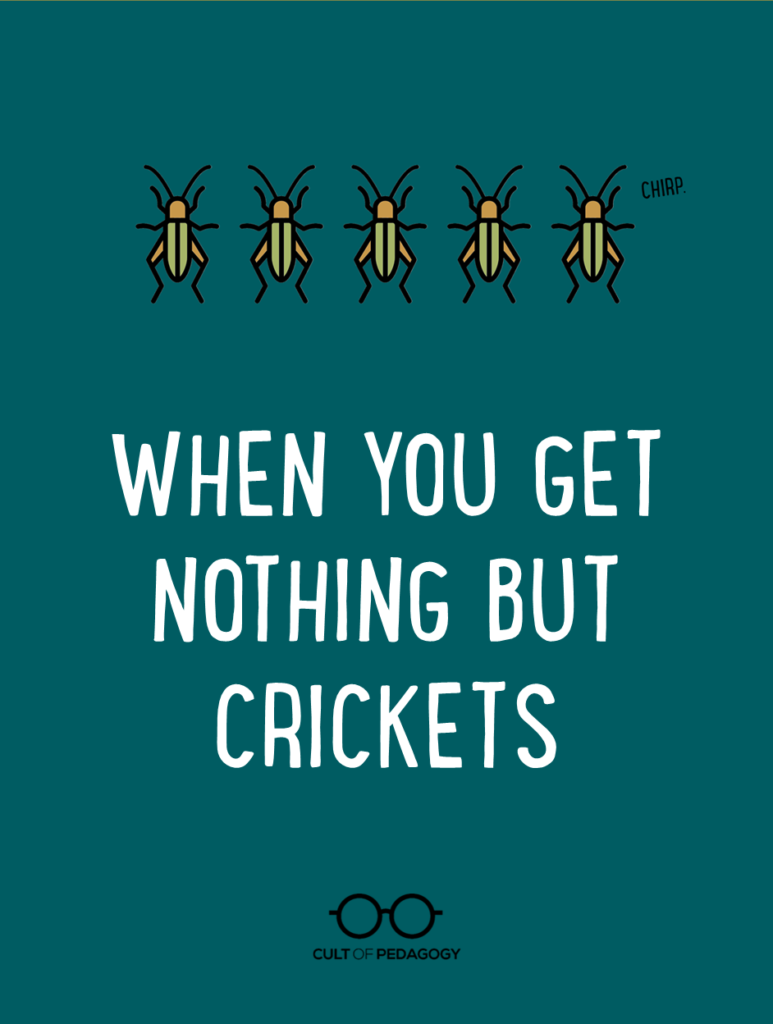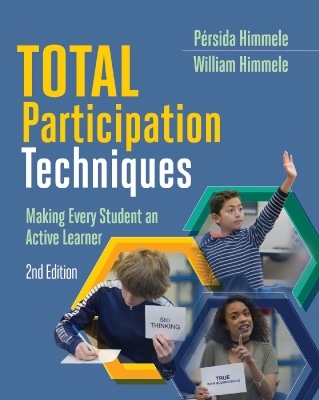
Listen to this post as a podcast:
Sponsored by Learners Edge and Microsoft Inclusive Classroom
This post contains Amazon Affiliate links. When you make a purchase through these links, Cult of Pedagogy gets a small percentage of the sale at no extra cost to you.
You know that thing where you’re talking to a group of people and you ask them a question and no one answers? And you wait a few more seconds, awkwardly, and nothing happens? It’s one of those funny little problems faced by a lot of teachers, coaches, speakers, ministers, pretty much anyone who speaks in front of groups: The speaker says something, hoping for a response from students or an audience, and what they most often get back are a couple of weak smiles, a grunt or two, and not much more.
Basically, crickets.
It’s mildly uncomfortable for everyone, both the speaker and the audience, but thankfully, the moment passes quickly and it’s no big deal. Still, it’s a fixable problem.
Why It Happens
Getting the silent treatment from a group you’re speaking to happens most of the time for one basic reason: People don’t want to look stupid. Within that broad umbrella of not wanting to look dumb, here are some more specific possible causes of your cricket problem:
- They know you’re not just talking to them.
If you ask a group of people, “How’s everybody doing?” very few of them will answer, because it’s not the same as if you were alone with them. One on one, you ask someone that question and they can give you some detail about how things are going, but in a group, the question is more or less rhetorical. A few extroverted people might mutter “good” or “great,” but no one is going to seriously answer you. The one exception to this is if you’re speaking to tens of thousands of people in some kind of stadium situation. In that case you’re a big fricking deal and the crowd is already going wild because you walked out on stage, so go ahead with your question. - They think everyone else gets it.
If you say to a group, “Does that make sense?” most people are going to act like it does, even if it doesn’t, because they assume everyone else in the room totally gets it and they don’t want to look like the lone dummy. Instead of telling you it doesn’t make sense, what they’ll do is either (A) turn to someone else to ask a clarifying question, which can look to you like rude chit-chat, or (B) come up to you after your presentation and ask the questions then. If this happens with more than a few people, you now have a small crowd to deal with. On top of that, the rest of the group probably would have benefitted from hearing that question and your response, but instead, you’re only having the conversation with one person. - You’re asking for too much.
Some questions are too hard to answer on the spot. For example, if you ask, “What is your favorite song?” some people will rack their brains trying to think of a song they like more than any other, THE song that totally defines them as a person. But if you just ask them to think of a song they really like, that’s much easier. - Someone in the room is intimidating (and it might be you).
When we’re in the presence of someone who intimidates us, it gets a lot harder to speak up publicly, especially if there’s a chance that what we say might be wrong or different from the norm in any way. This is about a thousand times more true if you’re around 13 years old and your whole goal in life is to fit in. So if you have a group that is especially silent, consider who’s in the room: Just one super popular kid or a person who is not particularly nice to her peers may be all it takes to keep the rest of the class from opening their mouths. Or the intimidating person might even be you: If you’ve ever ridiculed students’ questions or their responses to questions you have asked, very few of them will be brave enough to keep sticking their necks out. - They don’t know what the heck you’re talking about.
It could be that your audience is just really confused. This is where it helps to be a good judge of facial expressions: If people in an audience are confused, many of them will show it right on their faces, but if you’re not generally good at noticing that kind of thing, it could help to have a colleague come in and observe.
More Effective Ways to Increase Audience Participation
Here are some better ways to get your students—or your audience if you’re speaking outside of a classroom—to participate more.
1. Explain what kind of response you want.
Sometimes audiences freeze up when you ask a question because they aren’t sure what kind of response you want, if any. So the more specific you are with your expectations, the better they will be at giving you what you want. For example, you could say, “In a minute, I’m going to ask a question. What I want you to do first is think quietly about your answer. Then I’m going to ask for three volunteers to share their answer with the group.” Specific instructions like that will put your audience more at ease, and they’ll be more likely to give you good responses.
2. Ask for a show of hands.
As long as you’re asking about something people won’t be embarrassed to admit and that at least some people in your audience will probably say “yes” to, this is a way to start a conversation. So rather than say, “How was everyone’s weekend?” you could say, “How many people watched a sporting event this weekend?” From there, you can go to one of the people who raised their hands, ask them what they watched, and you’re off and running.
3. Ask one person a direct question.
We established earlier that everyone in your audience knows you’re not speaking only to them, so when you throw out a question to the room, individual people aren’t likely to move the spotlight to themselves. But if you go to one person directly and ask them a question, they have to respond. So instead of saying, “What did you think of that movie we watched yesterday?”, go to the kid in the third row and say, “Hey Paulie, what did you think about that movie?” Now Paulie could probably just shrug this question off or say, “It was alright,” so if you want to get a better response, try something like, “Tell me something about that movie that made an impression on you.”
4. Have everyone write down a response first.
When you ask a group a question, usually only one or two people will respond. This robs everyone else of the opportunity to answer. If this happens over and over again in the same group, many participants won’t even think about their own response, because they’ll know one of the more talkative people is going to answer anyway. One way to solve this problem is to have everyone write down a repsonse to the question first, then call on a few people to share what they wrote. This way, even if the room only hears a few responses, everyone actually reflected on and answered the question. And when you give everyone time to process in this way, you’re likely to get more and different volunteers than if you just ask the room cold; that’s because some students need more processing time before they feel confident enough to share their thoughts. In their book, Total Participation Techniques (see the end of this post), Persida and William Himmele tackle this problem with dozens of strategies that get every student in the room participating.
5. Do a think-pair-share.
Instead of having everyone write an answer, you could instead just have them turn to a partner and respond to them. This can be useful for meaty, content-heavy questions, where participants are processing something they’ve learned, or just your basic conversational ones. Try it: The next time you’re about to say “How’s everyone doing?” to a large group, instead, tell them to turn to a partner and answer the same question. If someone in the room is having a crap day, this may be the first opportunity they’ve had to actually share that with someone and maybe feel a little bit better as a result.
6. Do a better check for understanding.
If you regularly ask “Is that clear?” or “Does everyone understand?” you probably already know that this doesn’t always tell you who needs more help. Instead, give participants tools to let you know when they are confused: You could ask everyone to give you a thumbs-up or thumbs-down signal to indicate whether they’re getting what you’re saying or hold up colored response cards that can serve as answers to a multiple-choice question. Finally, as we mentioned in a previous post called Let’s Give Our Teaching Language a Makeover, simply switching from “Are there any questions?” to “What questions do you have?” tends to get many more people to actually ask questions.
Bottom line: If you feel like you’re doing all the talking up there, and you want to get more from the people listening to you, you might just need to make a few small changes to your delivery to turn a one-way lecture to a much better conversation.
Recommended Reading
Persida and William Himmele have established themselves as experts in getting all students to participate in class. Their book, Total Participation Techniques, offers 51 alternatives to traditional “stand and deliver” teaching, many of which will be useful to any speaker in any setting.
Join our mailing list and get weekly tips, tools, and inspiration that will make your teaching more effective and fun. You’ll get access to our members-only library of free downloads, including 20 Ways to Cut Your Grading Time in Half, the e-booklet that has helped thousands of teachers save time on grading. Over 50,000 teachers have already joined—come on in.






Right, classroom discourse should not be a version of Jeopardy. All response should be processed/rehearsed in the mind first. Think time is the sine qua non of all conversation. I would add that the students can be taught to recognize the type of question being asked and the teacher can translate the question down to the basic mind actions needed to answer the question. When asked to analyze, summarize, compare, hypothesize, evaluate,generalize, students need a metacognitive sense of how their minds work to answer the questions. Otherwise the long silences and the poor quality of the answers will continue. Once students understand and can use seven types of thinking, they can not only respond more effectively to questions, they can craft their own questions and run their own discussions. I am referring to the ThinkTrix typology. As the initiator of Think Pair Share I can say that the metacognitive ally of ThinkTrix is crucial to inclusive discussion. You can see more about the typology and its uses in a book published by Kagan ThinkTrix:Tools to Teach 7 Essential Thinking Skills… All this being said I think what you are proposing to teachers in this segment is what they need to know. If they don’t pay attention to what you have written, some will leave the profession earlier. Frank Lyman
Great stuff! There’s also a classic study on wait time. It showed that after asking a class a question, most of us wait less than a second. Increasing that to 5 seconds increases hands raised, questions posed without prompting, etc. Thanks for your wonderful blog. Roben Torosyan, Bridgewater State University (Mass.)
I think that “wait time” is challenging for most teachers…myself included. Students do need that time to process their thoughts, and we will have much more productive discourse in our classrooms if we give them that 3-5 seconds. It has been challenging over the past few months teaching synchronously via Zoom. The “raise hand” button is helpful, but I cannot always see all students in one screen.
One of my school requirements is that all students participate. Technology has solved that problem for me. There are several programs that allow for student participation, some are games others are straight forward question-answer solutions.
I use PearDeck for multiple reasons. (I do not receive any benefit from PearDeck.) This Google addon allows me to insert question slides at any point in my slides presentation. Each student is required to respond. I am able to see all responses (with student names) on my desk top or lap top computer. I am able to select any number of answers and project them using the video projector — these answers are without student names. This lends itself to a class discussion on selecting the best components to arrive at a “best” answer. This is also a good time to bring in the “think-pair-share” collaboration to arrive at a best answer and provide justification. This also gives me a good idea of where the students are in the learning process.
Another feature that I use frequently with low-stakes formative assessments is to collect the individual PearDeck answers and download them into a spreadsheet. I merge the spreadsheet with a mail merge and provide each student with an email that 1) gives the question, 2) gives the student answer, 3) provides the student a score and best of all 4) provides the student with the components that are expected with a fully correct answer. This feedback allows each student to see what they need to do the give a better answer — metacognition for everyone. Many of the formative assessment questions are used on the summative assessment — higher stakes of course.
Dennis,
Thank you for sharing a solution that you’ve found to work for your students in the classroom!
I loved you when said maybe someone in the class in intimidating and it might be you! Also, I think what you said about they might think everyone else gets it and be afraid to speak up and express that they don’t. Great suggestion for how to overcome the crickets!
Seriously great information for teachers, coaches or anyone who speaks to groups of any size, all in a short podcast. I’ve changed my thumbs up/thumbs down to thumbs up for “I understand” and thumbs sideways for “I kind of get it”….even if they really don’t kind of get it, it seems to be less insulting and still tells me what I need to know.
I agree that this was great information for teachers! I am a Kindergarten teacher and I also use the “Thumbs Up/Thumbs Down” method! Your idea to change it to thumbs up for “I understand” and thumbs sideways for “I kind of get it” is really great! This new method will definitely benefit the students in my classroom! Great idea!
I use thumbs up, sideways, and down. I can quickly evaluate how many “get it” and my follow-up question is “What can I explain better?” This gives me feedback on where their gaps in understanding lie and give me a chance to clarify without putting the students on the spot. They don’t mind responding if they’re “helping” me. I also follow up their answers with: “Do you need more practice with this material?” which can lead to creation of new worksheets or (better) different ways of working with the material, such as Kahoot.
As a new teacher, I’ve found myself in this “crickets” situation a few times now. I really resonnate with the point you made about students not wanting to look stupid. I’ve noticed in working with young people that they often know what I am asking for, but the fear of being wrong keeps them from answering. I’ve started using the “write it down before” method along with a think-pair-share to help get students more confident in their answer. This has been very helpful and I find it gets more students talking and engaged.
Thanks for your ideas. I definitely agree that I think students sometimes don’t answer because they are intimidated (by either you or other students in the class) and don’t want to look stupid. Even reflecting upon my own learning when I’m in a group setting I tend to hold back from answering because I don’t want to say the wrong thing. I think another reason too related to that why students might not answer is because they don’t want the attention drawn on them, even if it is just for a second. I know as I reflect on myself as a learner, that is sometimes why I don’t answer. I do think though, like you suggested, if students have the opportunity to write or discuss their answers beforehand they will feel much more confident sharing.
I can remember in classrooms where I felt uncomfortable or judged, not answering because I didn’t want to be wrong. I always flash back to the scene in Willy Wonka (the original, not that Johnny Depp trash) when the math teacher is helping the students with the chocolate math and Charlie says he only had one chocolate bar. I never wanted to feel like that!
This was very insightful for me. I have an unhealthy fear of awkward silences, and because of that, I often end up answering my own question before even giving a chance for it to be answered. Knowing some of the key reasons the crickets happen helps me assess the way I ask questions, and encourages me to implement these things to create more participation. Giving a few minutes to write down thoughts or an answer seems so practical and helpful. This allows the audience to truly think, rather than depending on someone else answering.
This post was very informative. It reminded me of when I started my first year of teaching. My husband is in the military and we had just moved to Texas in December. I started mid year in January teaching fourth grade. Prior to Christmas break, my students had different substitute teachers for almost two months, so they did not have much stability at school. I had the “crickets” and it showed on my first day. I learned quickly, though, that most of the time they really didn’t know what I was talking about. Although I taught a class with a large percentage of students with special needs, I went in with very high expectations. I’m not sure if they just weren’t use to having structure, if they had just not learned anything the past two months, or even both. As mentioned in this post, I learned quickly to pick up on. their facial expressions. Since all students process information at different speeds, wait time is so very important.
My story is similar to yours. I began my first year of teaching in October. The teacher before me decided to retire. She didn’t teach these students anything. I went into a kindergarten class full of scared little kiddos. I left a kindergarten interim position to take this job. I assumed that my new class would be on or around the same level as the students I left. They were not. I quickly found out that these students had no experience of whole group, sitting on the carpet, and sharing ideas. So when I would read a story and ask questions, the room was full of crickets. Once the shyness went away, and the students were not intimidated by me, the answers started flowing.
This article was amazing. I often reflect back on teachers or professors I had in the past and how I felt after a lesson. This article provided great tips and strategies on how to get students to comfortably share if they understand the lesson or not. It’s a great way to get students comfortable with expressing themselves. I know for me, I never felt comfortable asking teachers to reexplain information. I want to be that teacher where students are comfortable enough to say I do not understand, can you explain it again.
I truly loved this article so much because I’ve definitely experienced the crickets while sitting in lectures in college. During my student teaching I’ve never experienced the crickets, but I really wish I never have to. The strategies you listed like explaining the type of response that you want and writing down a response first. Being specific when teaching is such an important tool to have in our utility belt of teaching. This is so helpful when asking questions and plan on using this in future teachings! I also love the writing the response down first strategy because it allows for people to be involved and not feel pressured to answer the question perfectly (which is how I feel consistently when asked questions). I truly love this article and the added podcast portion of it as well!
Brooke, thank you for sharing this! So glad you enjoyed this post and podcast episode.
The article was very beneficial and helpful. It had a lot of strategies that I am going to use in my classroom. I liked the way that it showed by changing the wording of a question can get you a better response. Especially, instead of asking “What is your favorite” to “What is something you like”. I know when I am asked my favorite I overthink and spend too much time on it. By the time I think of my answer, the speaker is on to something else. Overall, I thoroughly enjoyed this article. I defiantly plan to use these ideas in and out of my classroom!
I listed to the podcast version of this blogpost and it was wonderful! I loved learning more about the “cricket problem” because this is an occurrence I have had in my classroom in the past. I really liked the idea about having the students write down their response to a question.
It’s hard for me to visualize what being the less-talkative, potentially lost audience member feels like since I was always the one that talked too much and dominated conversations (until I figured out how to let other people have a turn). I think making things more personal can help deal with a silent group, though I will have to be careful not to embarrass any of the shy or anxious students by directly addressing them in a way that makes them feel overwhelmed. With that being said, there are ways to direct a question at someone specific in a group without actually calling them out, namely through eye contact, that can encourage them to give an answer. I feel though that the best way to gauge the engagement and understanding of an audience is to use an individual or small group assessment during a discussion, briefly splitting the class up to write down their thoughts or answer some questions before getting back together, now with prepared material for the students to use as a guide in the discussion.
I really enjoyed this article and all the strategies that were shared. As an educator I think we have all experienced the “crickets” at least once. Think Pair Share is one of my favorite strategies to use. Sometimes students are more likely to share ideas with their peers. One strategy I would like to use more is the written responses. I can see how it can help those introverted students. If they can get their ideas down on paper, then they will be more encouraged to share their ideas aloud with the class. This was a great read!
The simple phrase “Turn and talk you have 2 minutes!”
While its not that simple to get them talking, if you start the year with allowing students to explore their voices everyday, and never give up, even when they are standing firm in silence,your doing the right thing.
Have a bi-weekly circle (even at secondary levels) be a part of what you always do! This will loosen tongues and make kids feel safe. It will translate into academic language.
Now the question is not so much as blank stares, but blank squares! Avatars, or initials, miles away from probing questions with a new normal in social dynamics. I’m shaking a little!
This is a beneficial article to help educators engage students in whole group discussions. I like how she broke it down to why there is a lack of participation. Although I was aware of some of the reasons, such as being intimidated, it was informative to know it could also be because educators may be asking for too much. Instead of asking what students did over the summer, teachers can ask if they were able to play outside. The strategies were informative as well. The variety of ways to respond can be utilized across a variety of grade levels. It is good to mix up how students respond too. Written responses, think-pair-share, and direct questioning are great ways to help the students be involved.
Glad you found this helpful Jennifer!
I thoroughly enjoyed this article. I often find myself asking myself why my students are not responding the way I anticipated them responding to a particular lesson. This article gave so many useful ways to have better conversations in my classroom. I particularly like the one of having everyone write down a response first. Many times the same students answer and it doesn’t allow for the other students to give their feedback. This approach allows for the voices of other students to be heard. This past school year I started ending my lessons with “What questions do you have?”, and it definitely benefited my students and myself. It just goes to show how changing up how you word things can benefit so many people. Thank you again for a great article!
I enjoyed reading this article. Sometimes as educators we do all the talking and expect the students to learn and know every question we ask. I really enjoyed the strategies Jennifer gave to encourage students to be more interactive on questions that may be difficult for students to respond out loud.
Glad you found this helpful Natalie!
What a great resource! These are very helpful suggestions for me teaching 3rd grade for the first time!
Giving think time is especially important to our introverted students – and there are a lot of them in our classrooms. What keeps introverts from participating isn’t necessarily shyness. It’s simply that they need time to think and even practice in their heads how to say something. Allowing for that time results in richer conversations.
Great article! I recognized some of these problems but had no solutions until I read this. I always hate when someone addresses a group and says “How’s everybody doin'” – They can’t really expect an answer from each person, so the question is actually insincere.
Love this and appreciate the many reasons why paired with strategies. A couple additional thoughts. When we are clear as to our identity with an audience as well as their identity with us, then we tend to set the culture as such. Am I a presenter, a teacher, a facilitator? Are they listeners, learners, participants? And I find that, to no surprise, if you want their voices, you must make offer an authentic, intimate audience for their sharing. Pair, yes. But also with a juicy question, with a real purpose and connected to your topic. That processing is powerful engagement. Lastly, I think the tone has to be set right away. If we start with them talking, they’ll likely talk more later. If we wait 10-15 minutes after only our sharing…um, crickets:)